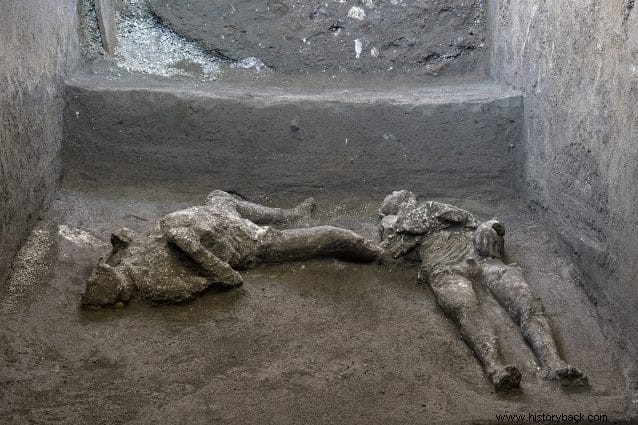Theater of the incredible discovery is the suburban villa of Civita Giuliana , the luxurious estate of the Augustan period with terraces that reached the sea in whose stables in 2017 archaeologists found the remains of three purebred horses.
Here the first excavations date back to 1907 , but after having excavated the Marquis Giovanni Imperiali - then owner of the land - he had those rooms buried without leaving adequate documentation.
"We were also lucky" says Massimo Osanna , Director of the Archaeological Park of Pompeii , "Because the compartment in which we found the bodies of the two men had escaped both the excavations of the early twentieth century , both to grave robbers ”. An intact environment and therefore particularly precious.

The bodies belong to two men, a forty year old and his slave, probably fleeing the fury of Vesuvius .
The presence of a cloak by wool (together with other evidence studied in recent years) could further support the new hypothesis of the eruption on 24 October (and not August 24, as canonically be considered).
It was possible to create a cast of the two victims with the same technique developed by Giuseppe Fiorelli in 1863 .
The first victim is, most likely, a boy between 18 and 23 years old, 1.56 meters tall. His head is bowed, with his teeth and skull bones still partially visible.
He wears a short tunic, no longer than the knee, of which the imprint of the drapery on the lower part of the belly is clearly visible, with rich and thick folds. Traces of fabric suggest that it is a heavy fabric, probably wool fibers. His left arm is slightly bent with the hand, well defined, resting on the abdomen, while the right is resting on the chest. His legs are bare. Near his face there are fragments of white plaster, dragged by the cloud of ash. The presence of a series of vertebral crushes, unusual for the boy's young age, suggests that he could do heavy work:he was probably a slave.
It was during the making of this first cast that the discovery of the bones of a foot took place, which revealed the presence of a second victim. He is in a completely different position than the first. His face is lying on the ground, at a lower level than the body, and the plaster has precisely outlined the chin, lips and nose, while the bones of the skull are partially exposed. His arms are folded with his hands on his chest, while his legs are spread apart and with his knees bent.
The clothing is more articulated than the other man. Under the victim's neck, near the sternum where the fabric creates evident and heavy folds, there are in fact clearly visible fabric marks which can be traced back to a wool cloak that was stopped on the left shoulder. At the upper part of the left arm there is also the imprint of a different fabric, that of a tunic, which seems to be long up to the pelvic area. Also near the face of this victim there are fragments of white plaster, in this case probably collapsed from the upper floor. The robustness of the body, especially at the level of the chest, suggests that also in this case it is a man, however older than the first, with an age between 30 and 40 years and about 1.62 meters tall.

“A very important excavation is that of Civita Giuliana - declares Massimo Osanna - because it was conducted together with the Prosecutor's Office of Torre Annunziata to ward off clandestine excavations and which returns touching discoveries. These two victims were perhaps seeking refuge in the cryptoporticus, where instead they are overwhelmed by the pyroclastic current at 9 in the morning. A death from thermal shock, as evidenced also by the contracted limbs “.
